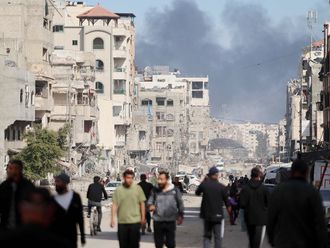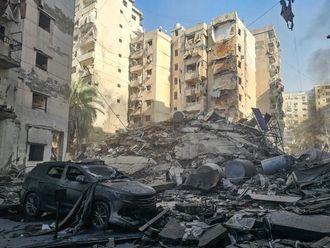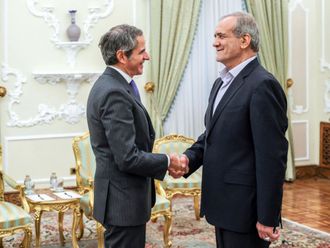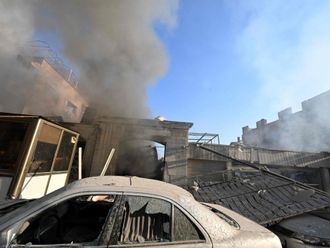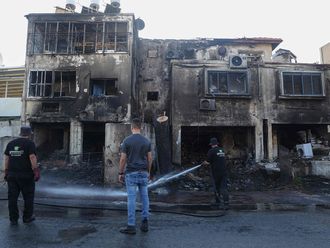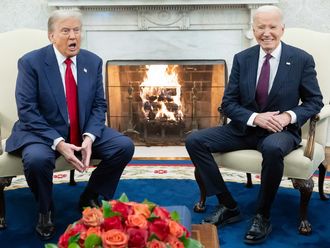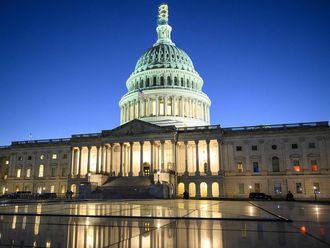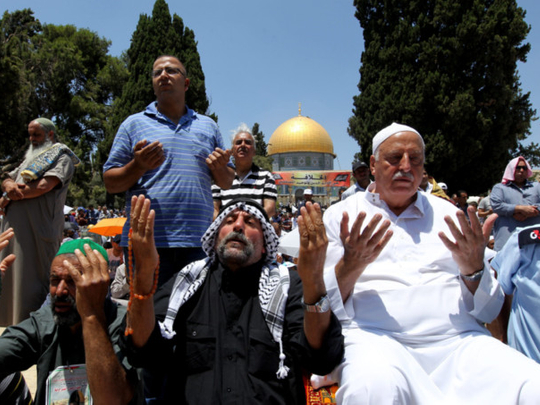
Ramadan in the ethereal city of occupied Jerusalem is a special occasion, but Fridays in particular have assumed a dimension that adds an altogether surreal feel to this holy month.
The old city of occupied Jerusalem has seven “open” gates yet it remains inaccessible except for the “select few” on whose religious holidays the West Bank is sealed off to keep Palestinians out and opened for them, without any barriers on the way to their holy sites.
On the other hand, for most Palestinians living in the West Bank, it is only on Fridays during Ramadan that they are able to travel to occupied Jerusalem, by virtue of “special permission” granted by Israel.
This year males and females over the age of 40 are allowed to make the journey, while those between 35-40 will require a special permit to cross the many military checkpoints to reach the Haram Al Sharif, which houses Al Aqsa Mosque and the Golden Dome of the Rock, from where Prophet Mohammad (PBUH) made the heavenly ascent. And Palestinians above 60 are granted unlimited access to the Haram Al Sharif during the entire month.
Those living in the Gaza Strip can only “dream” of visiting the Haram Al Sharif.
Together with this “generosity”, the Israeli military and police seal off the Jewish part of the city and reinforce their presence in the Muslim part, “for security reasons”, as they are wont to say.
A police helium-filled balloon equipped with a camera hovers nearby and a helicopter, also with high-tech monitoring equipment, circles the noble sanctuary permanently, reminding everyone below that they are being monitored.
This Ramadan, the longest in 33 years, with each day’s fast spanning 16 hours in the season’s hottest month, the Islamic Waqf (Jordan) which administers the holy site has erected many structures for shade from the scorching heat.
This led to much controversy prior to Ramadan, as Jews believed the sacred grounds where the Temple of Solomon may have once stood was being desecrated. Makkah and Madinah have continuously extended praying space, but in occupied Jerusalem that is denied, so the only option is to make praying outdoors as comfortable as possible.
A contingent of first aid professionals, assisted by many volunteers, has set up tents at strategic points on the Haram, bringing some relief to the many pilgrims suffering under the rigours of the journey.
Oblivious to all the foregoing, faithful pilgrims throng the narrow and jam-packed cobblestone alleyways of the old city, with a firm determination to reach the Haram Al Sharif, firstly trickling in and later streaming in to eventually fill the entire area. After the shady areas are taken, people spill out into the burning heat.
Munir had travelled from Jenin. His thoughts represent what most Palestinians feel: “It is one word, faith. We have faith in Allah, faith in our belief and our journey here is like a personal jihad.”
They depart from their villages in the West Bank, in some instances after midnight, and run into immense difficulties at the crowded military checkpoints. The journey is painfully slow, with the female soldiers, who conveniently “man” these entry passages, often humiliating the pilgrims. In the scorching heat, tempers fray but surprisingly the spirit of the month prevails and after many struggles they generally make it in time for the Friday prayers at Al Aqsa. For many, it is their first ever trip, while for others it is a once-a-year visit. The joy on their faces, on entering the “blessed grounds”, as the Quran describes it, expresses, “Thanks to God!”
Those who fail to make it, end up praying outside the precincts of Al Aqsa, and most times under the watchful gaze of the Israeli military personnel who are armed to the teeth and always edgy.
Palestinians who live in Israel “proper” and who describe themselves as “1948 Arabs” come in busloads from the north of the country, but they have no real hassles. In fact, they make it a family affair, unlike their West Bank brothers and sisters who do not enjoy the same privileges. Mohammad, who hails from a village in the Golan Heights, says: “We come here to protect the Haram with our lives if it may be!” Residents of the old city and nearby suburbs of (occupied) East Jerusalem join in as well.
In recent years, Muslims from foreign lands have been making their presence felt, namely Turks, Indians, South Africans, British Muslims and Eastern Europeans but Arabs from the Gulf are still rare, if nonexistent.
Listening to many answering their mobile phones, reminding their callers that they are in fact at Al Aqsa with pride in their voices, is indicative of the journey having become an act of resistance.
Also one notes the collision of religion and technology, with hundreds recording proceedings on the iPhones and many even reciting Quranic verses from their devices.
The large number of Palestinians in occupied Jerusalem also creates a momentary semblance of it being their capital but one is woken up from the illusion with all the police surrounding the Haram Al Sharif and the incessant whirring of the helicopter — a constant reminder to the faithful down below as to who “controls” the skies as well as the entrances to the holy place, where pilgrims are even “videotaped” by the Israeli police, as part of the monitoring process.
Those who have to travel long distances back to their homes leave immediately after the Friday prayers, flooding the narrow alleys, while others remain until the breaking of the fast and some even partake in the night prayer.
After the Friday prayers and to while away the time, many shaikhs take to “soap boxes” à la Hyde Park in London, each with his own faithful group of followers. One is spoilt with the many choices on offer.
Then a truly surreal experience takes place at Iftaar (the ending of the fast). Going by the age-old tradition, there is the “boom” of a cannon that still stands from the time of the Ottoman Empire in a cemetery in occupied East Jerusalem, followed by the call to prayer by the muezzin.
The faithful seat themselves on the ancient stones and partake of the food distributed by many international charities from as far as Australia, including the Sheikh Khalifa Bin Zayed Foundation. Some families bring along their own food and a picnic-like atmosphere prevails as a breeze passes over the noble sanctuary and the evening marks the end to yet another hot summer day of fasting.
The old city and occupied East Jerusalem’s Salahudin Street come alive on Fridays with West Bank Palestinians relishing goods and services denied to them in their “occupied villages or towns” and boosting business.
The downside to this is that the rise in demand pushes up prices, of bottled water, for instance, by five times the going rate. Bus fares double. One could attribute this to the ugly face of capitalism.
The return journey for West Bank Palestinians, exhausted after a day in the holy city, is much easier, especially through those military checkpoints that had made entry a slow and painful experience.
Rafique Gangat, author of “Ye Shall Bowl on Grass”, is based in occupied Jerusalem.


